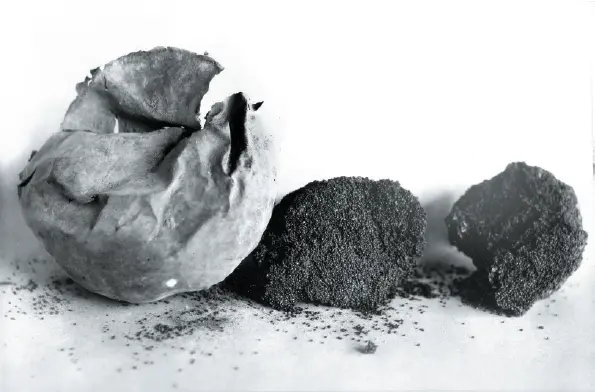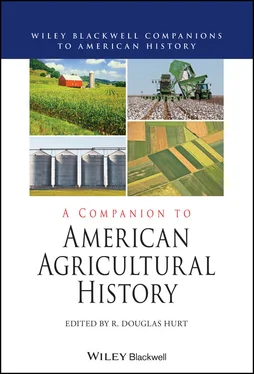Sumpweed is a close relative of sunflower, but it lacks attractive flowers. Nevertheless, selection for larger seeds and fruits resulted in achenes with volumes several times larger than those found in wild populations. The earliest known domesticated archaeological sumpweed specimens come from sites in west-central Illinois and date to at least 2500 BCE (Asch and Asch 1985; Wagner and Carrington 2014).The oily seeds of sumpweed constitute “an exceptionally nutritious package, comparable to sunflower” (Wagner and Carrington 2014). We have no direct evidence for how they were prepared prior to consumption, but their presence in 87 percent of 100 human paleofecal specimens from Salts Cave, Kentucky analyzed by Yarnell (1969 ) demonstrates that sumpweed fruits were readily consumed during the first millennium BCE. The ubiquity of sumpweed in dry Ozark rockshelter caches dating to as late as 1400 CE points to persistence of this crop until shortly before European contact (Fritz 1994a), and scattered domesticate-sized specimens are reported from protohistoric and historic sites from the Plains to North Carolina (Wagner and Carrington 2014). Why it disappeared, whereas sunflower survived, is one of the unanswered questions in eastern North American archaeology.
Early garden plots might have been located at the margins of base camps along alluvial terraces or in nearby upland zones, with clearings maintained by burning along with girdling and removing unwanted trees. Open patches of disturbed soil enriched by organic midden waste would have become beds in which selection pressures favored seeds that germinated and grew quickly, either because they were larger or because dormancy mechanisms were reduced by virtue of thinner seed coats. Domestication of chenopod ( Chenopodium berlandieri ssp. jonesianum ) (Figures 1.2C and 1.3) and knotweed ( Polygonum erectum ssp. watsoniae ) (Figure 1.2E), two more members of the Eastern Agricultural Complex, is seen as having progressed in these anthropogenic settings under the watchful gaze of gatherers—almost certainly women—who brought edible wild and weedy seeds home to cook and sometimes to plant where they were most likely to thrive (Watson and Kennedy 1991).

Figure 1.3 Two-thousand-year-old cache of domesticated chenopod ( Chenopodium berlandieri ssp. jonesianum ) seeds stored in a bottle gourd ( Lagenaria siceraria ), found at White Bluff rockshelter site in the Arkansas Ozarks. University Museum of Arkansas, Photo negative # 320115. With the permission of the University Museum of Arkansas.
The Riverton site in southeastern Illinois yielded the earliest (to date) flotation-recovered assemblages with a suite of Eastern Agricultural Complex crops: thin-coated chenopod; cultigen-sized sunflower and sumpweed; bottle gourd rind; and Cucurbita rind fragments (Smith and Yarnell 2009). The occupation at Riverton dates to 1800–1700 BCE. Most of the Riverton chenopod seeds and fruits (seeds covered by a papery pericarp) are pale, preserved without charring by having been deposited in prepared clay house floors that made the plant remains appear mineralized. This early manifestation of low-level food production shows that native crops were integrated into a broader subsistence regime dominated by walnuts, hickory nuts, hazelnuts, acorns, and of course, game animals and fish (Smith and Yarnell 2009).
Erect knotweed entered the Eastern Agricultural Complex by 1000 BCE, with pits in dry rockshelters in eastern Kentucky used to store this relative of Old World buckwheat, along with other Eastern Agricultural Complex crops (Mueller 2017). Paleofecal assemblages from Salts Cave, Kentucky, provide direct evidence for consumption of knotweed by cavers between 800 and 300 BCE, although the earliest specimens showing effects of domestication date only to c. 1 BCE (Mueller 2017). In the case of knotweed, selection was in favor of larger seeds with a high proportion of smooth and thin pericarps, a process that continued throughout the first millennium CE and into the second.
Maygrass ( Phalaris caroliniana ) (Figure 1.2D) joined the complex during the early first millennium BCE (Fritz 2014). This early season grass, ubiquitous in human paleofeces and storage pits, occurs at many archaeological sites far north of its natural range and always associated with known cultigens including thin-testa chenopod, large sunflower, and large sumpweed seeds. Flotation at sites across the Midwest and Upland South dating to the Middle and Late Woodland periods (300 BCE to CE 900) reflects increasingly high levels of maygrass production, with large concentrations of charred seeds found in the Illinois and Ohio river valleys. By 1050 CE, farmers had carried maygrass as far north as southern Wisconsin.
Little barley ( Hordeum pusillum ) (Figure 1.2B), the last member of the Eastern Agricultural Complex, becomes highly visible in deposits dating to the early first millennium CE. This relative of Old World barley added early season insurance, along with maygrass, to the diets of food producers whose middens include the entire suite of these crops in greater numbers throughout the first millennium CE. Little barley’s natural range includes the whole Midwest-riverine area, so a range extension argument does not work for it as it does for maygrass, but morphological signs of domestication include naked grains no longer covered by tightly adhering glumes and wrinkled, asymmetrical grains possibly reflecting selection for three fertile florets per spikelet rather than the single floret borne by wild plants (Hunter 1992). Little barley is ubiquitous in flotation-recovered samples from Middle and Late Woodland sites in Illinois, Missouri, and Arkansas, constituting up to 40 percent of total seed assemblages (Asch and Asch 1985).
Increased commitment to the food production sector of the economy is correlated with dramatic Hopewellian earthwork building and long-distance exchange networking between 200 BCE and 400 CE, and with post-Hopewellian advances in ceramic technology. Thinner-walled pottery vessels manufactured in the Midwest after 400 CE could better withstand long-term, direct exposure to heat during the cooking of gruels and other seed-based foods (Braun 1983 ). Population growth in the region is indicated by higher site densities and either longer-term or more frequent occupations of favorable locations. Together with the archaeobotanical record for heavy dependence on native starchy and oily seed crops, Late Woodland societies (400–900 CE) are sometimes called “farmers” (Johannessen 1993; Fritz 2019). Classification schemes that relegate food producers in the North American heartland to categories below the level of farming by applying such terms as “gardening” or “horticultural” fail to appreciate the settlement patterns, demographic trends, material culture, and especially the archaeobotanical subsistence remains from sites occupied during the first millennium CE.
Tobacco is not strictly a member of the Eastern Agricultural Complex because no species in the genus Nicotiana is native to this region. I mention it here, however, because tobacco was cultivated along with the native crops centuries before maize became important. Native Americans grew tobacco ( Nicotiana rustica and possibly N. quadrivalvis ) in eastern North America no later than 2000 years ago. Smoking pipes date to centuries earlier, but native wild plants may have been smoked before tobacco was acquired (Wagner 2000). Tobacco seeds have been recovered from three sites in Illinois dating between 100 BCE and 400 CE (Asch and Asch 1985; Simon and Parker 2006), and residues on a possibly earlier pipe from Ohio tested positively for nicotine (Rafferty 2002).
Читать дальше












